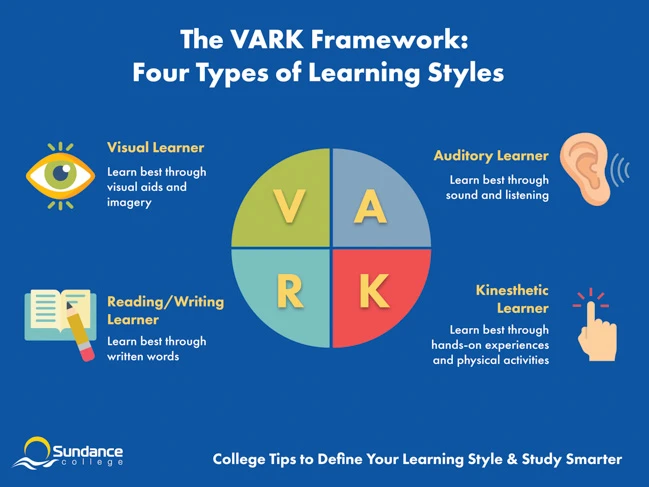Blog / College Tips to Define Your Learning Style & Study Smarter
College Tips to Define Your Learning Style & Study Smarter

Explore our Diploma Programs
- Business, Hospitality, and Legal
- Health and Human Services
- Technology
Table of Contents
Albert Einstein once said, “Everybody is a genius. But if you judge a fish by its ability to climb a tree, it will live its whole life believing that it is stupid.”
These words are a powerful reminder of how diverse human abilities are and this applies to learning: we don’t all understand in the same way or learn the same way. Some of us learn better by seeing, some by hearing, some by reading and writing, and others by doing.
To help you succeed in college, we previously provided study tips for online success. Today, we are going to look at different learning styles and how knowing yours can help you learn and study smarter.
So, what is the best way to study in a career college?
To answer this question, let’s turn to science. For over a century, psychologists have been investigating the most effective strategies for successful learning. Their findings encompass a range of valuable insights. For example, did you know that cramming may yield favorable results only for exams and fail to aid long-term information retention?
Most of us are a combination of more than one type of learning style. But one thing is for sure: Understanding your dominant learning style can be a game-changer when it comes to studying smarter and boosting your academic performance in a career college.
In this article, we’ll explore each style in detail, share how to identify your personal learning style(s) and provide practical tips and techniques tailored to your preferred way of learning to help you make the most of your studies in a career college.
What are the Four Main Learning Styles?
While working as an inspector for New Zealand’s educational system in the 1980s, and observing over 9,000 lessons in classrooms, Neil D. Fleming saw that some excellent teachers were not reaching some students while some mediocre teachers were. This observation gave rise to the idea for the VARK model, which has now been in use since 1987.
The VARK model categorizes learning styles into four main types: Visual, Auditory, Reading/Writing, and Kinesthetic.

1. Visual Learning Style
Visual learners absorb information best through visual aids and imagery. If, to recall that difficult math formula in high school, you closed your eyes and tried to picture the page of your notebook, mentally scrolling to the specific place where that formula was — this is a sure sign you’re a visual learner.
2. Auditory Learning Style
For auditory learners, the best way to absorb information is through sound and listening. If you’re a fan of audiobooks and podcasts, and your family and friends admire your ability to recall verbatim what they told you they wanted for Christmas five years ago, chances are you’re an auditory learner.
3. Reading/Writing Learning Style
Representatives of this learning style process information most effectively through written words. If it was enough for you to read a poem 3–4 times at break before a lesson and then recall it and recite it to the class, giving the impression that you’d been learning it for at least a week or more, you’re a reading/writing learner.
4. Kinesthetic Learning Style
Kinesthetic learners thrive on hands-on experiences and physical activities. If you liked to do laboratory work on mixing different substances in flasks and observing the reaction during chemistry classes or experimenting with communicating vessels in physics classes in high school, the kinesthetic or tactile learning style is for you.
Which Learning Style is More Effective?
There is no one-size-fits-all answer to this question because each learning style has its strengths and benefits. The superiority of one learning style over others depends on how well it fits your personal cognitive processes and preferences as well as the subject matter being learned and your specific learning goals.
For instance, if you take one of our health and social services programs, your course will include First Aid & CPR training and certification which involves practicing on mannequins and splinting your classmates’ limbs. This is a good example of hands-on training which, by its nature, is kinesthetic. However, the course will also include diagrams (visual) as well as verbal lectures and instructions (auditory) and students can take notes (reading/writing learning). This course exposes students to all learning styles.
It often happens that using a learning style not common to your personality is necessary because the information you need to absorb may be available only in a particular format or you’re required to learn information in a non-preferred format by an instructor.
So, relying solely on one learning style may not lead you to optimal learning outcomes.
How to Identify Your Personal Learning Style?

To help you assess your learning style, follow these five steps:
- Analyze your interests and preferences: Do you prefer communicating via email or via phone? Listening to music or reading a book? Doing workouts in the gym or needlework at home?
- Look at your study habits: Is going over your notes or from a textbook help you prepare for an exam better? Or is it listening to a recorded lecture or attending a study session to discuss the course materials what makes you absorb the information more effectively?
- Consider the times you excelled in studying in the past: Was it a hands-on learning experience that was the most impactful for you? Or was it a conference you attended that helped you memorize the material better?
- Take online learning style quizzes: There are numerous platforms on the web that provide learning style assessments. One of them is the VARK questionnaire.
- Determine your personal learning style: After taking the four previous steps, you may discover that you identify with more than one learning style. This occurs frequently since learning styles are more of a spectrum than clearly defined classifications.
Research indicates that a multimodal approach that combines different learning styles and strategies is preferred by 60% of students. Many teachers use the VARK model to tailor their teaching to the different learning needs of their students. You can use an understanding of your learning needs to help you succeed in college!
You can leverage your preferred learning style while also incorporating elements from other styles and thus benefit from a well-rounded learning experience and achieve stunning educational outcomes!
College Advice for Different Learning Styles
Now that you know what learning style best matches your personality, you can find tips related to it in one of the subsections below:
Tips For Visual Learners
As a visual learner, you will better absorb and memorize information if you:
- Break up large chunks of text by illustrations including colorful diagrams, graphs, and charts
- Color code different topics or use highlighters to organize and categorize information
- Create mind maps or concept maps to establish connections between ideas
- Watch educational videos and use online tutorials to enhance your understanding
Tips For Auditory Learners
To succeed in a career college as an auditory learner student, it makes sense for you to:
- Engage the auditory senses through recitation and reading aloud
- Participate in group discussions and debates to verbalize and process information
- Record lectures or important study material to listen to them on the go
- Utilize mnemonic devices and create rhymes or songs to facilitate memory recall
Tips For Reading And Writing Learners
As a reading/writing learner, you’ll succeed in academic education if you:
- Take thorough notes during lectures and review them later for reinforcement
- Summarize and paraphrase information in your own words to enhance comprehension
- Engage in active reading by highlighting key points and writing annotations
- Create flashcards and study guides for active learning and test yourself regularly
Tips For Kinesthetic Learners
To maximize your learning potential as a kinesthetic learner, you can:
- Incorporate hands-on activities including performing experiments, participating in workshops, take advantage of practicums to enhance learning and retention
- Engage in role-playing or simulations to apply theoretical knowledge to real-life situations
- Use flashcards or manipulative tools to reinforce learning through touch and movement
- Take regular study breaks to energize your mind and body through physical activities like stretching or walking
General Study Tips for College Students

Regardless of your learning style, certain study strategies are beneficial for all college students. Consider using the following tips for your study success:
- Time management strategies to create a structured study schedule: Plan your study sessions in advance and allocate specific time slots for learning course materials and doing home assignments. We recommend scheduling 30 hours per week to start your college education, breaking down your study sessions into manageable segments from 25 minutes to 4 hours per day. This will keep you organized and enable you to cover all the necessary material without overwhelming yourself.
- Creating a conducive study environment to minimize distractions: Find a place that is calm and comfortable so you can focus on learning without interruptions. Reduce distractions by turning off notifications on your devices and keeping your study area clean and organized.
- Utilizing mnemonic devices to improve retention and recall: Mnemonic devices, such as acronyms, visual imagery, or rhymes, can help you remember complex information. One device you might recall from high school math is PEMDAS which stands for the order of operations: Parentheses, Exponents, Multiplication and Division, Addition and Subtraction. Create memorable associations to aid in memory recall during exams.
- Leveraging resources at college, such as instructor support and study groups: Take advantage of the resources offered by your college. Collaborating with peers or seeking help from instructors experienced in your learning can enhance your understanding and provide valuable support.
Find more study tips in our article: “We Surveyed Faculty on Tips for College Success: This Is Their Advice”
Harness Your Learning Power with Sundance College
At Sundance College, we offer the following advantages to help you succeed:
- Expertise in catering to different learning styles: Our instructors are trained to recognize and adapt to diverse learning styles. They master a variety of teaching methods and incorporate visual, auditory, kinesthetic, and reading/writing techniques to cater to your individual needs.
- Availability of online formats and diverse learning materials: We offer online learning options that provide flexibility and convenience. Our online platform includes a range of multimedia resources, interactive modules, and engaging learning materials to facilitate effective studying.
- Assistance in identifying your learning style: All Sundance College students start their educational journey with a course that helps them make the transition to post-secondary education and teaches them how to make the most of their chosen career education path as they prepare for the workforce. Topics include learning styles, goal setting, note-taking, and testing.
To help you identify your strengths, learning styles, and potential career paths, you can connect with one of our admissions advisors. We are always happy to answer your questions about the learning experience at Sundance College.
Subscribe for more career advice
Blog Categories
Share on:
